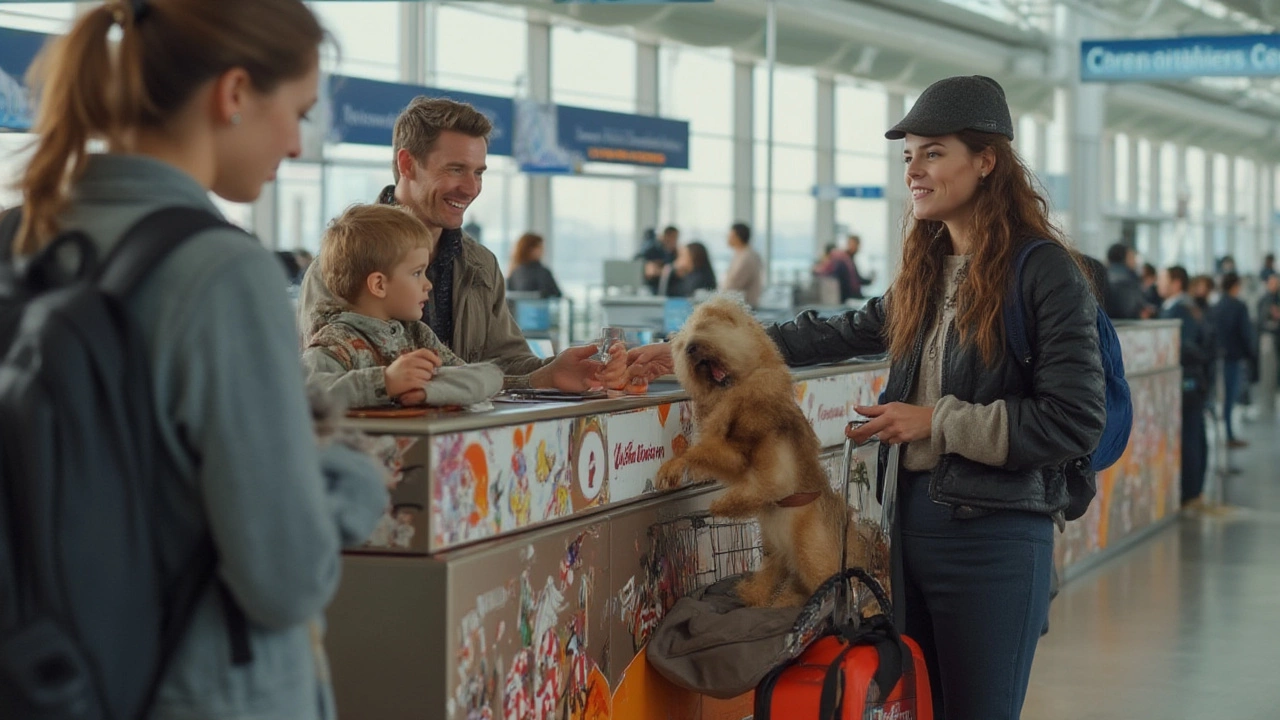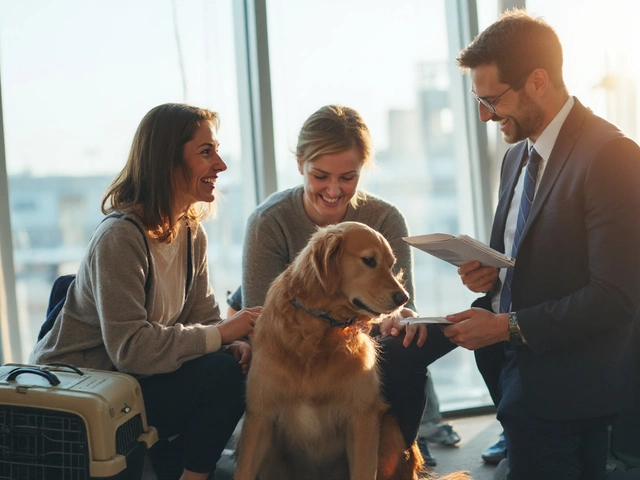Ever tried squeezing a 50-pound furball under an airplane seat? You’d need a miracle—and probably a stiff drink. People love traveling with their dogs, but as soon as your pup graduates from tiny chihuahua status, the rules change big time. If your dog weighs the same as a small child (or your gym bag filled with bricks), you’re about to hit a wall of fine print and policies that airlines don’t exactly shout from the rooftops. Let’s break this down so you avoid awkward airport surprises and unhappy pups.
Airline Rules: The Not-So-Little Problem With Large Dogs
Let’s rip the band-aid off—most airlines won’t let you bring a 50 pound dog in the cabin, even if you bribe every gate agent with gourmet dog treats. Airlines set tough limits on pet size in the cabin, usually for these reasons:
- Space under seats is pretty tiny. Airlines expect pets to fit in a carrier that slides under there. We’re talking carrier size limits around 18” x 11” x 11”—the canine equivalent of a studio apartment in NYC.
- There’s a max weight limit, too. Domestic US airlines cap the total weight at about 15-20 pounds (and that includes the pet and the carrier combined).
- Federal safety rules matter. If evacuation happens, everyone—including your dog—has to get out quickly. Big animals blocking aisles or trapped under seats aren’t safe. Flight attendants stress over this a lot more than travelers realize.
The only time you might see a 50 pound dog stretched out at 35,000 feet in the cabin? If that dog is a trained service animal (and no, emotional support animals don’t count anymore on US airlines after new DOT rules in 2021). For everyone else, emotional support status, doctor’s notes, or charismatic puppy eyes won’t override the rules. Air Canada, Delta, United, American—they’re all strict. JetBlue and Alaska may sound pet-friendly, but the weight and carrier size limits still block big dogs from joining you up front.
European and Asian carriers aren’t much different. Even Air France’s “La Compagnie Des Animaux” isn’t offering in-cabin for large pups. Turkish Airlines is famously reasonable, but even they cap in-cabin pet plus carrier weight at 17.6 pounds (8 kg). Quirky exception: La Compagnie (the French boutique airline) occasionally let larger dogs ride in their own seat, but you’ll pay extra, and it’s rare. Bottom line: for dog in cabin, size matters way more than you want it to.
Why Do Airlines Have Size & Weight Restrictions?
So, who decided big dogs deserve the cargo hold? It’s not just about passenger comfort, although nobody wants to lose a shoe to an excited golden retriever. Safety and logistics really rule the day here.
- Panic scenarios actually happen. If a plane needs to be evacuated, huge animals can bottle up aisles, slow people down, or panic and run in the opposite direction. Cabin crew get special training for anxiety and pets, but they’re not miracle workers.
- Cabins are tight. Even in fancy business class, the aisle isn’t wide enough for a 50-pound dog (or their carrier) to hang out. Carriers are supposed to stay at your feet, not in laps or open seats.
- Allergies and fear. A quarter of travelers are allergic to dogs or afraid of them. Airlines actually get complaints when travelers see a big dog boarding, regardless of how nice your pooch is.
- Bathroom breaks. There really aren’t any options for dogs to relieve themselves mid-flight. Smaller dogs can sometimes use absorbent pads in their carrier, but a large dog can’t squat in a carrier without popping out or making a mess.
This isn’t just the airlines being mean or greedy. The FAA and international equivalents set these rules, and airlines have to stick to them or risk big fines. Pets in cargo aren’t exciting for anyone—especially pet owners—but it’s a compromise that lets people bring their animals safely if the animal’s too large for the cabin.
Airlines also constantly battle for every square inch of cabin space. That’s why overhead bins are tiny, why they measure your carry-on twice, and why the under-seat area has barely grown since the 1960s. Unlike lamps or duffel bags, your dog can get stressed, anxious, or even sick in a cramped environment. Animal rights groups keep a watchful eye for this stuff, and there’s lots of legal fine print from the Department of Transportation, the IATA, and animal welfare organizations that all dictate how airlines can handle pets in the air. The only loophole anywhere? Legitimate, trained service animals—those with the stuff to pass behavioral tests and handle packed flights without incident. But those animals get scrutinized, and airlines reserve the right to deny access to any animal they believe can’t handle the cabin safely, no matter what their vest says.

Alternatives For Traveling With a Large Dog
If you’re set on flying with your big dog, it’s not totally hopeless. There are a few options if you get creative, plan way ahead, and deepen your wallet:
- Cargo Hold as “Checked Baggage” or “Manifest Cargo”: This is how most large dogs fly. Airlines like Delta, United, Alaska, Air Canada, Lufthansa, and KLM offer this—some only on direct flights, others year-round. Here’s the deal: you’ll need an airline-approved hard-sided crate. Book way ahead (there’s a limit on animals per flight), pay $125-$500 depending on distance, and arrive at the airport early. The good crates have ventilation on all four sides and latches you can easily open in an emergency.
- Private Charter or Pet Jet Service: If you’ve got deep pockets, companies like Pet Airways, VistaJet, and NetJets let your dog ride beside you. These are full-on private flights or a shared charter with fellow pet owners. If you live near LA, New York, or London, it’s pricier than first class, but your pup gets the best ride possible.
- Special Ground Transport: If you’re not crossing oceans, a pet transport van or even a one-way road trip using Rover or Wag’s pet transportation service can get your dog safely to your destination, stress-free and crate-free.
- Connecting Destinations: Sometimes you can fly to a border city, drive across, then fly domestically in another country with looser rules (for instance, Mexico to the US used to be more relaxed; now it’s tightened up, but research is key).
- Pet Ferry, Train, or Ship: The Queen Mary 2 is legendary for its “Pets On Deck” program, letting big dogs ride New York to Southampton. European trains also allow larger dogs on leash and muzzled—ask about size tickets beforehand.
Planning ahead matters. Never, ever sedate your dog before a flight (airlines actually ban this because it’s risky under pressure). Crate-train your dog weeks in advance so it feels like a safe space. Use familiar bedding, and pack dog-safe treats, a favorite toy, and a water drip bottle. Airlines sometimes update rules, especially after pet-related incidents, so always check the official pet policy before booking. Pro tip: book your dog’s spot first—if the flight won’t accept a large crate today, they won’t budge later on.
Top Tips for Smooth and Safe Pet Travel
If you want the trip to be less stressful for you and your dog, it’s all about preparation and flexibility. Here’s what works:
- Visit your vet within 7 to 14 days of the trip for a health certificate, especially flying internationally. Most destinations need recent rabies, tick, and parasite clearance.
- Order an airline-approved crate that allows your dog to stand, turn, and lie comfortably. Start crate-training far ahead if your dog isn’t used to it.
- Choose direct flights if possible to reduce time in stressful airports and avoid missed connections for your pet. Early morning or late-night flights help beat heat restrictions (some airlines ban dogs from cargo on hot days).
- Label your crate inside and out with your contact info, veterinary details, and ‘Live Animal’ stickers. Freeze a bowl of water the night before—a full bowl spills, but ice will melt gradually for a drink mid-flight.
- Arrive early, stay calm, and give your dog lots of exercise before heading to the airport. Tired dogs travel better than restless ones.
- Don’t feed your dog a big meal right before flying. Small snacks work. Carry extra food, paperwork, and a list of emergency vets near both ends of your route.
- Always keep an extra leash, calming spray, and cleaning supplies handy in case there’s a mess before or after landing. Dogs can get nervous with new smells, crowds, or turbulence.
If your 50 pound dog is still a puppy or a senior, double check with your vet—it’s extra risky for these ages. Flat-faced breeds like bulldogs and pugs also face extra danger due to breathing problems at elevation. Some airlines ban them entirely from cargo.
And don’t forget: every country and state has their own entry rules. Hawaii, for example, is famous for strict quarantine (up to 120 days!) unless you jump through a ton of hoops months before landing. UK, Australia, and New Zealand all have quarantine, too. Always ask the embassy or consulate and your airline about current entry requirements.
Last thing: track your dog with an Apple AirTag or a GPS tracker inside the crate. People have reunited with lost pets this way when airlines misplaced the cargo. It’s a little tech insurance for peace of mind.
Wish airlines let big dogs curl up under your seat and join you for snacks, but for now, the dream stays on the ground. But with enough planning and patience, your best buddy can still join the trip—just probably not in the cabin. Make it as safe, calm, and fun as possible; your dog will reward you with a tail wag and a slobbery kiss when you land.







